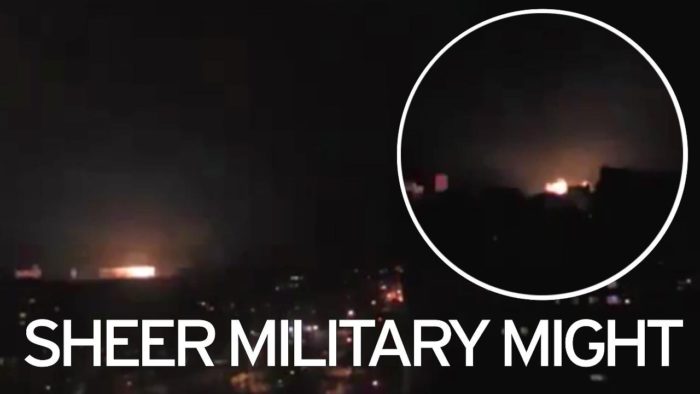14th April, 2018
In response to the chemical weapon attack on citizens by Syria government, U.S, France and United Kingdom carried out a joint strike on strategic spots to whittle the power of Syria.
While the coalition claimed they hit three sites in precision strikes, the people of Syria, largely supporters of the government, on Saturday trooped to the streets to mock President Donald Trump who coordinated the action against Syria.
USA NEWS in its tweet, said: “Smart missiles from U.S coalition sent to destroy heinous ASAD/Russia/Iranian chemical facilities……”
The government’s supporters danced and jubilated, claiming that the missiles were warded off by Syria ground- to-air defence system.
Although no independent assessment has been received on the level of destruction, some reports claimed success and others claimed the missiles were thwarted by Syria defence.
Partisangirl @Partisangirl posted a video on how Syria defence brought down a fighter jet. “Glorious! video of #Syria-n airdefence system shooting down US tomohawk missiles over #Damascus.”
van Sidorenko also posted: #Syria #Damascus Now. Beginning of a gathering by the masses in the Umayaad square in support of the Syrian Army and to send a message of defiance to the triple aggression – Syrians Are Celebrating a “Victory” this morning in the Capital of Damascus.”
In the aftermath of the attack, CNN asked some pertinent questions on the U.S attack.
“First, and most basic, what exactly is US policy in Syria? President Donald Trump said just two weeks ago in a speech in Ohio that the US would “be coming out of Syria like very soon.” Now, Trump has presided over a large-scale bombing operation aimed at several targets in Syria, including in Damascus, the Syrian capital.
So what is the Trump administration policy? Is it that Syrian leader Bashar al Assad must go, which has been the stated policy of the United States going back to the early days of the Syrian civil war under President Barack Obama? Or is there simply just a red line on Assad’s use of chemical weapons, but not much more?
The answer is far from clear. When President Trump announced the US-led strikes on Friday he emphasized the latter, while his own ambassador to the UN, Nikki Haley, said earlier this week that there is no political solution in Syria with Assad still in power.
Second, beyond responding to the Syrian regime’s use of chemical weapons, does the Trump administration have a plan to protect Syrian civilians in the war that has destroyed much of their country over the past seven years?
Nearly half a million Syrians have died in the war, of which chemical weapons have only killed a tiny fraction. On the campaign trail, candidate Trump sometimes raised the idea of creating “safe zones” for Syrian civilians.
Is the next step for the Trump administration the creation of such zones? And how would these work? Such safe zones would require “no fly zones” because the Syrian air force has hitherto enjoyed total air superiority allowing them to drop chemical weapons, “barrel bombs” and other munitions more or less at will. Enforcing such a no fly zone is complicated by the fact that there are considerable numbers of Russian aircraft flying over Syria.
Third, might Trump’s laudable concern about civilian casualties caused by chemical weapons in the Syrian civil war change his view about Syrian refugees entering the United States? Right now the Trump administration has effectively banned the entry of Syrian refugees into the US, despite the fact that most are women and children.
Fourth, do the strikes mark some kind of turning point between Trump and Russia? The President had been loathe to critique Russia President Vladimir Putin, yet on Friday he had harsh words for the Russians, saying: “To Russia, I ask: What kind of a nation wants to be associated with the mass murder of innocent men, women, and children?”
Fifth, when US Secretary of Defense James Mattis spoke at a press conference at the Pentagon on Friday night he said the legal authorization for the strikes was under the president’s Article 2 authority in the Constitution as commander in chief. Many legal experts — as well as a number of members of Congress — would beg to differ. Attacking Syrian regime targets, as opposed to ISIS targets has not been authorized by Congress which is supposed to sanction US military actions, although recent presidents have tended to minimize the role of Congress in such matters.
Sixth, is there a bit of “Wag the Dog” to all this? This was the accusation, adapted from the title of a popular movie, against President Bill Clinton who, in the midst of the Monica Lewinsky affair, launched military strikes against al Qaeda training camps in Afghanistan in August 1998 following al Qaeda’s bombing of two US embassies in Africa.
As Mark Twain is supposed to have observed, “History doesn’t repeat itself, but it does rhyme.”
